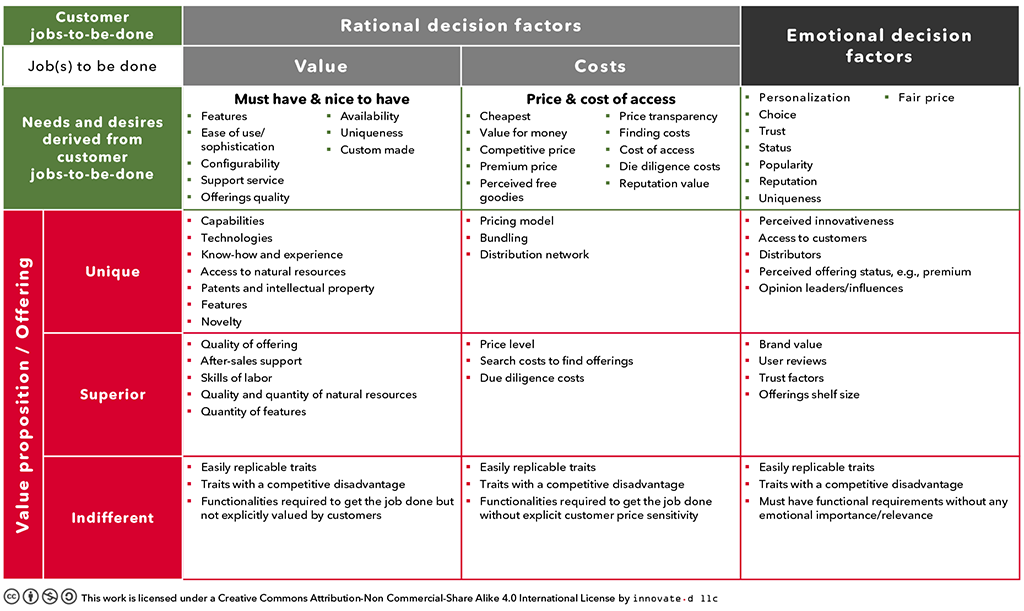Recent trends in business model innovation and strategy design have taught us that success depends on a holistic understanding of the customer needs and jobs-to-be-done. Business model development tools help relate offerings and associated value propositions to customer needs in a way such that they are desirable, feasible, and viable. Although approaches based on these tools are sound, they are insufficient as they fail to address the competitive environment in which firms operate. The Competitive Positioning Canvas (CPC) enlarges the modern strategy toolbox with a framework that supports understanding how the value proposition allows a firm to position itself in a competitive market. It focuses on identifying potential competitive advantages through differentiation or superiority, both from a rational and emotional point of view. It helps finding a not so simple answer to the simple questions “why should any customer do business with you rather than your competitor” taking a customer rather than firm-internal perspective.
Think about the last time you were buying a watch. What made you chose one brand over another? Or was your choice driven by features, style, size, availability? Or was your purchase an impulse decision? What was the job you wanted to get done with buying that new watch? Was is knowing the time, or was it more, or something different, like gaining status, tracking your fitness or having your e-mail around your wrist? These are all legitimate questions you have answered implicitly or explicitly when buying that new watch. Now put yourself in the shoes of a watch manufacturer, whether it is Swatch, Apple, Tissot, Rolex, Blancpain, or any other brand – their chief strategist, business developer, product manager, or even CEO. Wouldn’t your job be much easier if you knew the answers to all of those questions? How do you identify and collect these insights, and more important, how do you ensure that your perception of the ideal customer decision criteria is realistic as well as holistic? This is where the Competitive Position Canvas (CPC) comes into play. The CPC provides a visual language for discussing and understanding the competitive positioning of a firm. It ensures by design that the value proposition characteristics support the competitive positioning.
THE CHALLENGE AT HAND
Traditional strategy scholars address the competitive positioning challenge from the firm’s viewpoint. They take an inside-out view to answering the question “what makes the firm superior to its competitors”. Superiority can be achieved through competing on differentiation, competition on price, or positioning in a niche segment. The key challenge with this approach is that it assumes a seller driven market and relegates the customers’ view on value to the second row.
More recently, novel approaches focusing on customers and their jobs-to-be-done have been developed. They put the customers and their needs, their felt pains, and sought-after gains center stage. The competitive positioning is derived by mapping the firm’s value proposition underlying its offerings to those needs. This approach works well in an environment with limited competition, for example, resulting from disruptive characteristics of the offering.
Although inherently sound both approaches to competitive positioning fail to answer two key questions in an explicit and holistic way:
- Why should a customer prefer the firm’s offering over that of its competitors?
- How will competitors react to the firm’s competitive positioning over time?
THE COMPETITIVE POSITIONING CANVAS
The CPC, as shown in Exhibit 1, is a canvas to support documenting insights that lead into identifying a firm’s competitive positioning in the market in a structured and holistic way. It provides a common language to executives, strategists, and consultants, for leading the discussion and decision about competitive positioning.
Exhibit 1 – Competitive Positioning Canvas (CPC)
UNDERSTANDING HOW CUSTOMERS DECIDE
Describing a firm’s competitive positioning, using the CPC, starts by understanding how customers decide with whom to do business and why.
It first focuses on rational decision factors. This means understand what are the must have and the nice to have value characteristics driving customer decisions. These are typically required features, product and service quality, usability, after-sales support, to name just a few. It also means understanding their perception of costs, looking a price (cheapest, value for money, competitive, premium) as well as access costs (costs related to searching for an offering and actually buying it).
The second dimension to explore in order to understand customers decision factors is the emotional dimension. Emotional decision criteria can be classified based on the nature of the relationship between the firm and the customers, that is, either one-way (brand, reputation, advertising) or bi-directional (customer intimacy, pro-activeness, distribution channels). As shown in Exhibit 1, the top row of the CPC (green) supports identifying and structuring the needs and desires derived from the job(s) the customer wants to get done.
Consider a customer whose job-to-be-done is opening an account in which his employer can deposit their salary. Must-have criteria sought-after may be a checking account with an IBAN number, a customer card allowing retrieving money at ATMs, and 24/7 on-line access to the account balance. Nice to have criteria may be a credit card, an overdraft limit, and interest payments on cash deposited in the account. Emotional decision criteria could be the location of the closes branch, the friendliness of the personnel, and brand recognition.
COMPETITIVE POSITIONING AND THE VALUE PROPOSITION
The value proposition describes how the offerings of a firm meet customer needs and desires and thus create value for them. Once the decision factors underlying the customer needs have been described in the green part of the CPC, the firm’s offerings and value proposition characteristics are identified and related to the different decision factor categories (red part of the CPC). Each value proposition characteristic is classified into one of three categories, depending on how it contributes to the firm’s competitive positioning.
Uniqueness
Characteristics of the value proposition identified as unique are those that no other firm is currently offering and that customers are valuing. Uniqueness may result from specific capabilities, unique technologies, access to resources, or patents, to name just a few. Uniqueness is the most compelling attribute when identifying competitive advantages.
Successful uniqueness characteristics are hard to copy by competitors and are preferred by customers over substitutes. In most cases, uniqueness is a temporary attribute. Its potential expiry must be dealt with as part of defining a firm’s competitive positioning strategy.
Superiority
Some of the value proposition characteristics may not be unique, but superior to those of competitors. If these characteristics are valued by customers, they contribute to the firm’s competitive positioning. Offering superior product or service quality is a typical superiority value proposition characteristic. Other superiority characteristics are ease of use, choice, after-sales-support, or being the cheapest. Superiority characteristics may also be related to emotional decision factors, like brand recognition. In comparison with uniqueness characteristics, superiority ones are easier to copy and compete against.
In the context of building a competitive advantage through superiority, firms need to find the right trade-off between value delivered to customers through superiority and the cost of achieving that superiority. Being superior at all cost is a failing strategy. For example, a digital watch being failsafe over a ten-year period, may be a superior characteristic, but due to the speed of technological advancement, not one that is valued by customers.
Indifference
Most characteristics of the value proposition can be classified into the indifferent category. Indifferent characteristics are needed to satisfy the customer’s jobs-to-be-done, but do not add value that customers are willing to pay more for. They are not relevant for defining a firm’s competitive advantage. They are called hygiene factors.
Consider a bank offering a checking account. Being able to withdraw cash from the bank’s ATMs is considered an indifferent value proposition characteristic. It is required to satisfy the customer’s need for access to cash.
A firm must decide which characteristics of its value proposition to compete on and which to consider indifferent but necessary. The competitive positioning of a firm is significantly defined by that decision. It should be distinct from that of its competitors.
CONCLUSION
The CPC is a tool that allows describing the characteristics behind the competitive positioning of a firm in a holistic way. It provides a common language. It is the first step in defining a firm’s target competitive positioning and ensuring a strategic differentiation in a crowded market. It helps identify potential challenges that may need to be addressed.
NOTE
The Competitive Positioning Canvas is licensed for use under the creative common attribution-noncommercial-share alike 4.0 international license (http://www.creativecommons.org/licenses/by-nc-sa/4.0/). It may be downloaded from https://www.innovate-d.com/wp-content/uploads/2019/01/framework-cpc-a0.pdf

